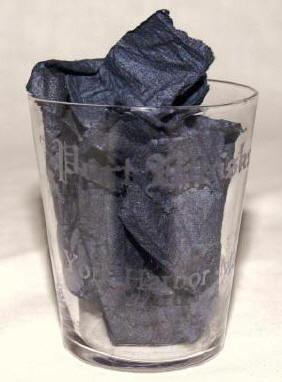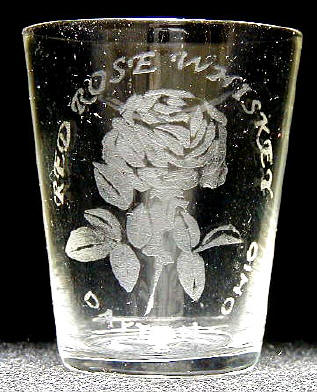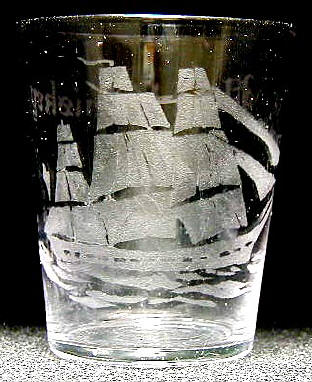
 |
|
|
|
|
|
|
This special edition of SOTW brings you up to date on two "questionable" pre-pro glasses that listed on eBay on March 14, 2010 and sold a week later. Both are fakes.
 |
 |
| "Pre Pro Etched Shot Glass Red Rose Whiskey Dayton Ohio" | "Etched Shot Glass Port Whiskey York Harbor Maine" |
The glasses appeared in two separate auctions. The first listed as "Pre Pro Etched Shot Glass Red Rose Whiskey Dayton Ohio" and featured a rose stem. The second auction ran with the title "Etched Shot Glass Port Whiskey York Harbor Maine" (screenshots from both listings have been cached: click on the links to see the full pages). The glass was etched with an image of an old-fashioned clipper on one side and text that read "Port Harbor / York Harbor Maine" on the obverse.
The seller in both cases was usbca. The person behind the id is Tim Smith, who also sells as invisitrax. He disposed of a small collection of genuine pre-pro glasses on eBay earlier last year; some of you will be familiar with the name and id.
The two glasses prompted concerns about their authenticity the moment they listed because, although they appeared to period thin-walled shots, the labels just did not look "right". Plus, both listed as private auctions, which usually means that the seller has something to hide and doesn't want more informed collectors tipping off high bidders about what they might be buying. A lengthy discussion about their possible origins began in the Chat Room.
oldwhiskey dropped the seller a line and asked where he'd found them - he replied that they had come from an estate sale in the Grand Rapids area and believed them to be authentic (see exchange).
Scrutinizing auction listing pictures and theorizing only gets you so far. At some point you actually have to take a look at the glass to determine whether it's genuinely pre-pro. The seller had been generous enough to offer to take them back if not as claimed, so the Poo-Bah loaded billion-dollar bids into the Snipe-O-Matic to guarantee a win and took the Rose for $53.76 and the Port Whiskey for the opening price of $19.99.
The two glasses arrived via Priority USPS in a timely manner and heavily insured. Right out of the box, they were clearly fakes. The Rose was cleverly designed and executed, but the Port Whiskey was covered in smudges and fingerprints! Ackkk. A quick check with a loupe revealed why they were so obviously fakes - the labels had been "etched" in the true sense of the word. A corrosive etching cream had been applied and the label created by removing the surface of the glass. The cream creates a very distinctive pebbly surface to the label, much as heavy rain-droplets scar a pristine sandy beach. The effect is difficult to capture photographically, but I think you can appreciate from the photographs below that the labels have a grainy appearance.
 |
 |
 |
||
| Note the grainy appearance of the labels -- it's caused by application of a corrosive paste or cream that has eaten away at the glass in an irregular punctate fashion. | ||||
|
||||
The majority of pre-pro glasses were not acid-etched. The very earliest ones were, but the process involved transferring a protective coating of wax or other impervious material to the portions of the glass that were to remain pristine, then allowing hydrofluorate gas to eat away at the exposed potions. The result was a frosted label with little or no texture, as is seen on the earliest Truog glasses. These labels were hardy but they were also muted, which is why they don't display too well. Most collectors have at least one etched glass on their shelves: a common Fulton Whiskey from Myers & Co of Covington, KY: compare how well this glass displays with a Hayner, for example.
Creating hydrofluoride-etched labels was time-consuming, labor-intensive, and expensive, so the glass designers switched to a simpler technique that produced the acid-etched look but that could be automated to allow advertising glasses to be produced by the thousands. Most of the glasses we treasure so much were "etched" using a rubber stamp that applied an adhesive of some kind, and then were dusted with a vitreous material of varying granularity. The dust stuck to the label and after the glass had been put back into the kiln for a while, the two became one. The resulting label was more striking than the acid-etched original, but it also wore off -- but then they were intended as short-lived advertising vehicles rather than 100+ year-old antiques that someone was willing to pay three figures for.
I reboxed both glasses and returned them to Mr Smith, who kindly refunded both the original purchase price and shipping costs in full, even though that meant he was left out of pocket on the transaction.
I don't believe that these glasses were listed with the intent to deceive - the Port Whiskey is so obviously a botched job that no self-respecting faker would try and pass it off as the real thing. I think this was someone's little basement project - someone who was curious to know if he or she could reproduce the look of a vintage glass using genuinely old, thin-walled blanks. Luckily for us, the modern etching techniques produce a label that is very distinctive and easy to recognize as being modern. We're also fortunate that the old fonts disappeared from usage many years ago and even if one goes looking for them, it's almost impossible to find a typeface that looks authentic. Plus the design templates that are available to a modern etcher lack the quality of a pre-pro original, so no matter how clever the design, it's never going to look "right" to a seasoned collector. For now at least.
|
Note that you can browse
many previous |
SOTW: Thursday April 15, 2010
Copyright ©2002-2010 pre-pro.com. All rights reserved.
"eBay" is a registered trade mark of eBay.com. There is no relationship, either actual or implied, between pre-pro.com and eBay.com.
Please contact the glassmaster with questions or comments